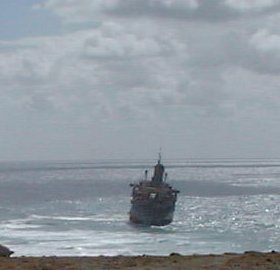|
Madeira - a wetter island in the Atlantic |
Hols index |
Roger's home page
|
|
| Our holiday in Fuerteventura, 2004
May 9 to 16 |
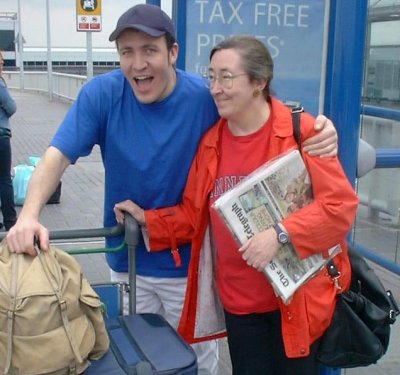 |
 |
A colleague of Lesley's has an apartment in Fuerteventura, Islas Canarias
which she rented to us for a week.
Expedia, a widely advertised web booking agency would have charged
us £215 each for a 23 hour journey involving a night
in Madrid!
So we went for First Choice (late Air 2000) the package holiday
company. They gave us a flight-only deal for half that price flying from
Gatwick to Fuerteventrua in 4 hours.
George took us to the airport. |
|
The car park at Fuerteventura Airport is divided into sections marked with
icons representing:
- The traditional exports of the island: tomatoes, goats and goats milk
cheese.
The latter is protected by the Denominación
de Origen Queso Majorero.
- The biggest export now: sea, surf, sand, sun (I assume that is a
sombrero) and
 ! The name Fuerteventura
means strong winds and it lives up to its name. ! The name Fuerteventura
means strong winds and it lives up to its name.
|
 |
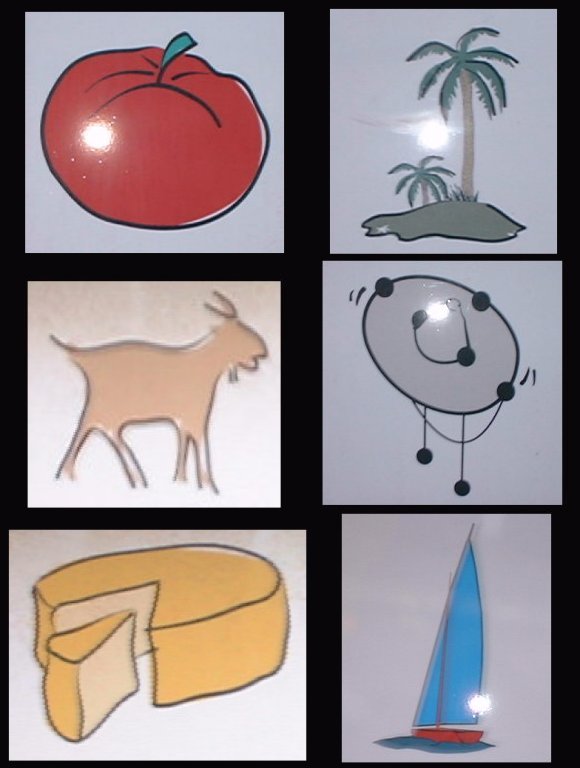 |
|
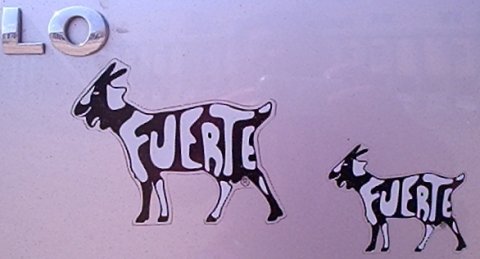 |
 |
The background to this page is derived from a goat sticker common on
the island, seen here on the back of a VW Polo. |
|
The apartment in which we were staying is in El Cotillo,
a quiet town near the northwest tip of the island.
This is the view from the balcony:
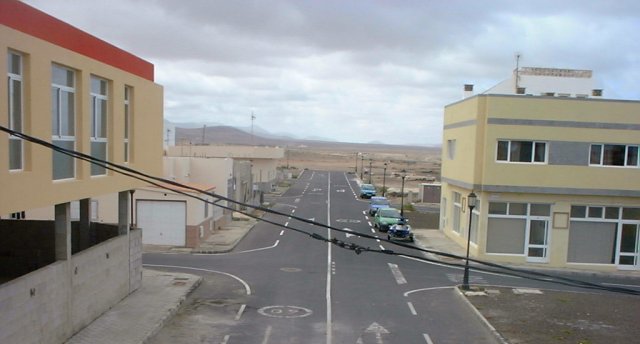
The road stops and the desert begins! |
Roger says: It is a principle of mine that I never
get lost. But I will occasionally admit to being temporarily disorientated.
On Fuerteventura I felt more disorientated than usual. It was probably
due to the unique, barren landscape - lunar describes it quite well.
Also there are plenty of hills to orient by but their shapes need to be
learnt carefully. For example, with a fleeting glance one could confuse:

the Montaña de Tamacile with:

the Volcan de Tindaya. |
On every beach there are stone circles about three metres diameter
created by previous visitors.
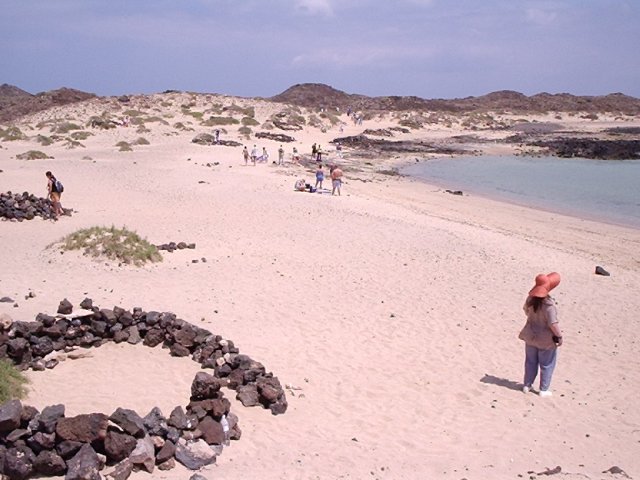
If you just want to sunbathe, you look round for an unoccupied circle
and colonise it:
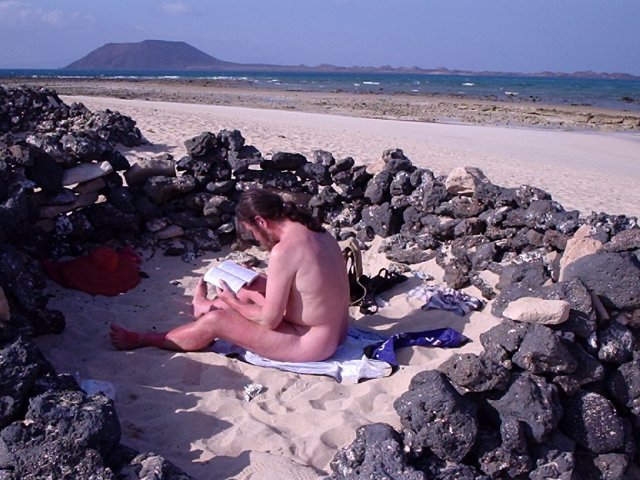
This is not out of modesty - more than one web site says 'all
Canary beaches are Clothing Optional' - but for shelter from that <expletive
deleted>  . .
(The first of the above two pictures was taken on the Island of Lobos
just off Corralejo on the north east corner of the island. Lobos
can be seen in the background of the second picture.)
People get quite proprietorial about these circles:
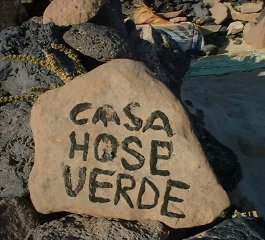 |
 |
Putting a name on the entrance
|
or in this case fetching mortar to make a horno, a traditional Canarian
outdoor oven. |
|
 |
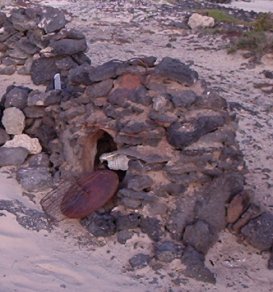 |
|
 |
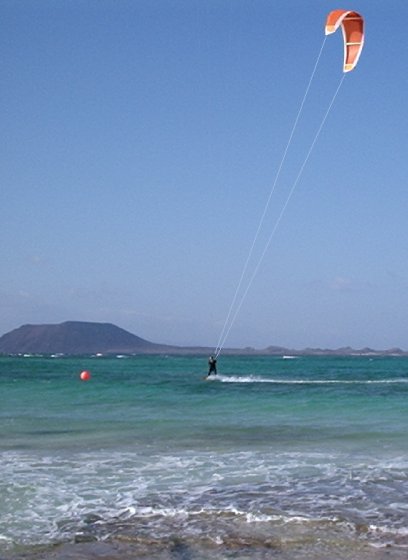 |
 |
Of course some people come to the island because they like the
 . .
This is kitesurfing and also one leg of the World Windsurfing Championship is held here.
|
|
This is Lesley's interpretation of the  as a silk painting.
as a silk painting.
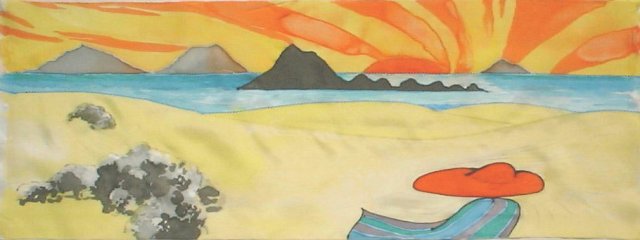
Lesley says: My only Spanish was learnt when my mother took me as teenager
to the Costa del Whatsit: Dos cafes con leche, per favor.
The phrase has served me well and it is nice when two coffees and dos
cervezas (beers) can be had for €4, the lot. |
On the west coast lies the wreck of a once splendid passenger liner,
the S.S. American Star (aka S.S. Australis, aka
several others names - see this history). She was driven on to
the treacherous rocks of this coast by a Force
11  .
(An account of the
wreck by the engineer in charge.) .
(An account of the
wreck by the engineer in charge.)
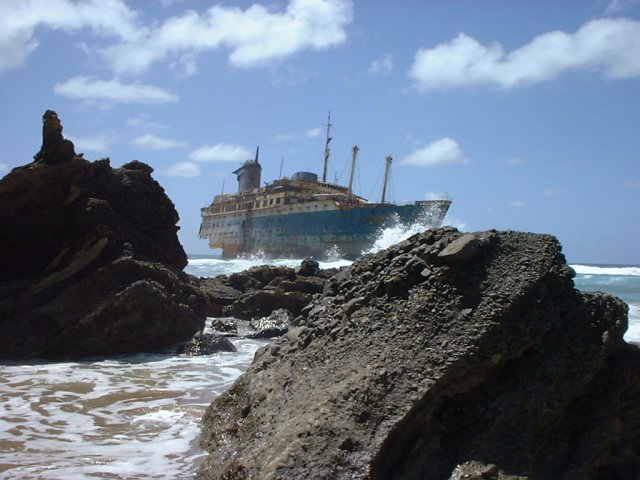
There were no casualties when she went aground but since then eight
people have been killed while trying to get to the wreck. Among those
who did get on board and came back alive was the photographer of the picture
below left. Note the stark warning on
this page about the ship:
Achtung!
On this part of the west coast das Schwimmen is absolutely,
lethally dangerous!!!
My picture on the right is taken looking back in the opposite direction. |
The guide book offered a number of ideas for the origin of the name
Canary Islands. One was from canis, dog. George commissioned
us to come back with pictures of Canary dogs. This was not difficult
because they are allowed to wander the streets at will. These two
are probably closest to the breed that the Guanches, the original
inhabitants of the islands kept.
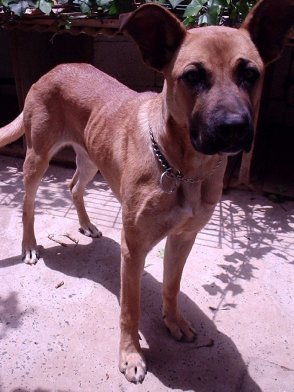 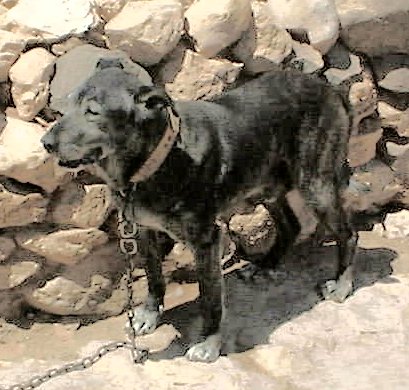 |
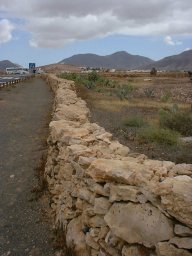 |
 |
When a Cumbrian farmer comes to this island:
-
He will be amazed at the lack of rain. The island gets about 120
mm per year. Ambleside often gets that much in one day and gets 2060
mm in a full year.
-
He will feel at home with the dry stone walls even though their materials
may seem unusual in some cases and the fields they enclose may be nothing
but rocks.
-
If he encounters the popular local sport of
Lucha Canaria [two separate links], he will say 'this is just
Cumberland and Westmorland Wrestling with a different starting hold'.
|
|
Most of the drinking water is desalinated sea water. For crop
irrigation they probably use agua recyclado, ie. treated sewage.
Water engineers on the Canaries have looked enviously 500 km to the north to Madeira.
Some parts of Madeira receive 3000 mm of rain per year and fresh water is allowed to
cascade in a profligate manner into the sea - as in this example on the right seen
between
São
Vicente and Seixal.
from The Brit in Madeira, April 2009
A number of sources close to the Regional Government have reported that the
Madeiran leadership has received several requests from the Canary Islands to supply
the Spanish archipelago with fresh water.
Nonetheless, the requests have received a negative response from the Madeiran authorities
who feel that such a move could endanger the reliability of Madeira's water reserves
as well as the island's capacity to assure the regional water supplies,
especially during the summer months.
|
 |
 |
|
Camels were used for ploughing as well as beasts of burden.
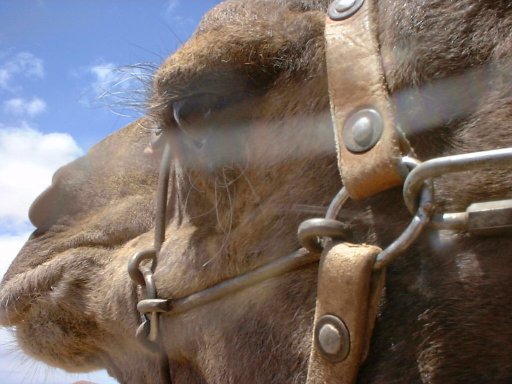
On several of my pictures I got my hair in front
of the lens because of the  . .
|
With all that  one wonders why they would bother to look for any other source of power. But here a poor little
donkey is being used to drive a grinding mill.
one wonders why they would bother to look for any other source of power. But here a poor little
donkey is being used to drive a grinding mill.

This is the only one of my Fuerteventura images that I have uploaded to Wikipedia.
Two different people have had a go at improving the rather dark original and it has been used in more than one article.
|
The island has a lot of geology.
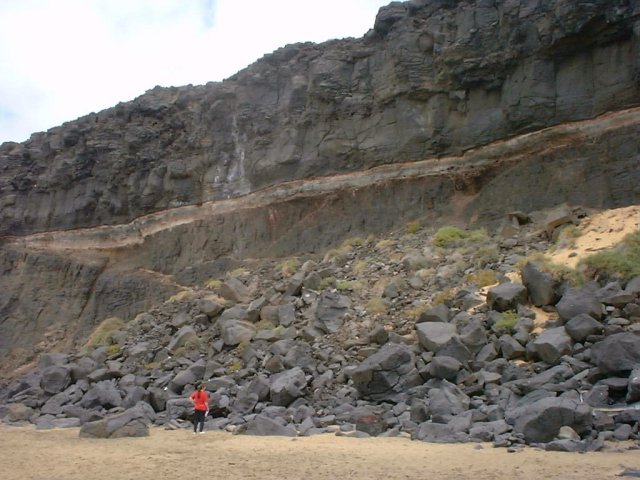
Here one thick layer of volcanic outpouring has been overlaid by a
narrow band of alluvial gravel and sand followed by another five metres
of volcanic rock.
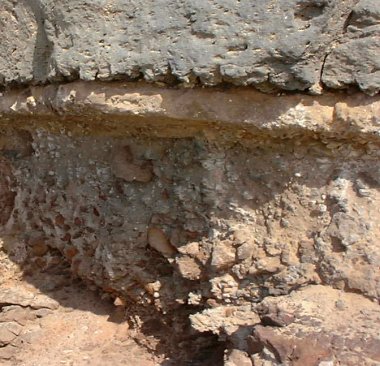 |
 |
Looking at the alluvial band more closely it looks as though the top
eight centimetres or so have been metamorphosed by the heat of the lava
above.
Cliffs south of El Cotillo. |
| The thing that looks like a wall in the picture on the right is a granite dyke.
Molten rock has forced itself into a vertical crack. It has cooled very slowly
and formed hexagonal columns, in this case lying horizontally.
Mouth of the Black Cave just north of Ajuy - created by wave action.
See also these vertical dykes
at Achadas da Cruz on Madeira.
The curious little stones below are called
lapilli they were spewed
out by a volcano and fell as enormous, hard hail. The left hand one
is much as it fell. The others show progressive degrees of erosion
by wave action.
Beach north of El Cotillo also seen on other beaches. Compare with these much more
amorphous lapilli
seen in Madeira.
|
 |
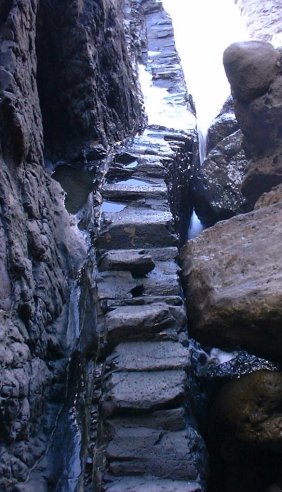 |
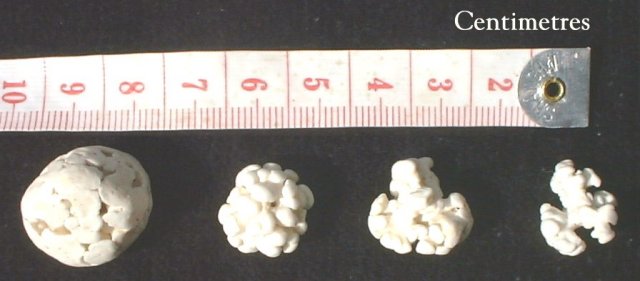 |
For power, they are making some use of all that
 .
This is the Parque Eolico at Cañada de la Barca: .
This is the Parque Eolico at Cañada de la Barca:

This power transmission line dives into the sea to connect
Fuerteventura with Lanzarote which can be seen in the background:
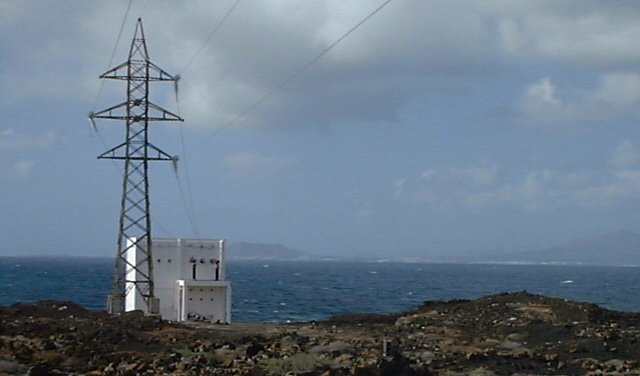 |
|
|













